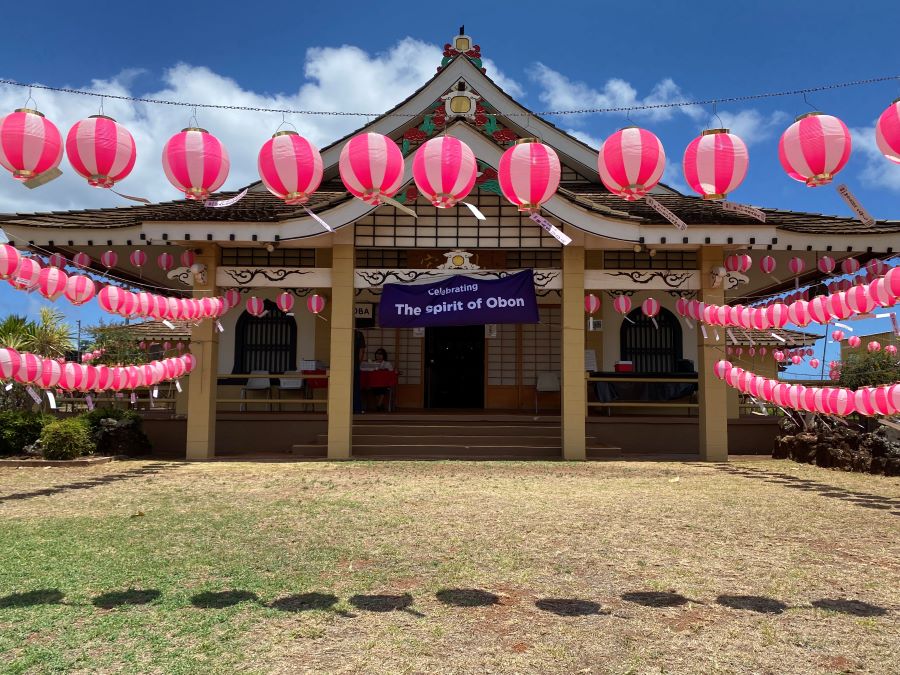After 2-year Break, Spirit of Obon Resumes in Hanapēpē

By Amanda Kurth
Every year for over a century, the town of Hanapēpē has come together to celebrate the spirit of Obon, or Bon, an important observance of the Japanese Buddhist tradition on the 15th day of the sixth month.
While the Kaua’i Buddhist Council canceled all in-person Obon festivities for 2020 and 2021, individual temples continued to hold services virtually until this year, when the gathering returned with festivities and a workshop in place of dancing.
“Even if there’s no bon dancing, if you are a Buddhist or a person of Japanese ancestry, you will understand that the tradition of honoring your relatives will continue,” said Gerald Hirata, president of the Sōtō Zen temple, on what it felt like to be back in action this year after a two-year break.
The word Obon comes from Sanskrit, which means suffering. Hirata explained the Buddhist folklore and its ties to dancing.
“At the time of the Buddha, a disciple of his saw his mother suffering in the realm of hungry ghosts. She couldn’t eat, she couldn’t sleep, she was always hungry, always thirsty,” Hirata said. “When the mother was released, this disciple was so happy, he danced with joy.”
The gathering is meant to honor that history, with its ties to both happiness and gravity.
“Although it is a joyous time and we dance with joy, that component is attached to the suffering, that release from suffering,” Hirata said.

Traditionally, bon dancing is remembered as a nighttime activity, but this year a Bon Odori workshop takes place each afternoon once celebrations kick-off.
“Each region has a local dance, as well as different music,” said Mary, a longtime resident of Kaua’i, who enjoys volunteering her time in the community.
The Sōtō Zen temple stands unmistakably along Kaumuali’i Highway at the bottom of Moi Road in Hanapēpē, and was dedicated to bringing the 2,500-year-old teachings of Shakyamuni Buddha to America.
The Buddhist-Confucian custom of Obon evolved into a family reunion holiday during which people return to ancestral family places and visit and clean their ancestors’ graves, a time when spirits of ancestors revisit household altars. It has been celebrated in Japan for more than 500 years and traditionally includes a dance, known as Bon-Odori.
“In past years around 8 p.m., the traditional dancing would start with the older generations, now there’s an interest and the younger generations are learning” noted Mary, who didn’t want to give her last name. “One of the things I love about Bon is that at the end of the dance on the last day of celebrations, the dancers would always add another step to the dance. It’s a continuous circle of old and new.”

The Zenshuji Temple on Kaua’i had its beginnings when McBryde Sugar Company was expanding at the beginning of the 20th century. Many villages, called camps, were established to house plantation laborers from all over the world. Japanese customs, however, acquired new observances when Obon came to Hawai’i, adding food and game booths that are now a vital part of the local festivities.
When asked what the food at the event was like, many at the event on Saturday were quick to share their anticipation for a local favorite, the flying saucer. It’s a sandwich with a sloppy joe filling, heated up in a handheld pie iron, creating the signature sealed and concentric ring pattern. Soto Zen Temple’s Obon Festival organizers noted that the Hanapēpē temple is “the original home of the Flying Saucer.”
“It’s a staple eat on Kaua’i,” said Nicolas Nacion, who worked with his father Nicolas Nacion Sr. at the McBryde Sugarcane Plantations when he was growing up. “I was a young kid then and my food was hamburger or hotdog, and we used to sit around for lunch, talk story, and share something similar with all the other workers from around the world.”
Events run through Sunday, June 19 from noon to dusk at the Hanapēpē Soto Zen Temple. The temple grounds are open to the public for exhibits and activities and to honor loved ones.
Food booths open at 4 p.m.; the “Let’s Bon Dance” workshop 2-4 p.m.; the StoryBook Theatre Rainbow Parade is 4:15 pm.; the Torao Hikariyama Concert is at 5 p.m.; and the fire burning ceremony begins at 6 p.m.




